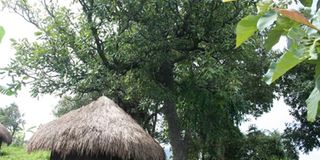Shea nut tree under threat in West Nile

A shea nut tree in a homestead in West Nile.
What you need to know:
Shea nut tree, which grows widely in northern Uganda, provides various opportunities for farmers if the potential could be tapped. But could face extinction if its destruction is not checked
While the economic and cultural values of the shea nut tree have become clear, there are some worrying developments taking place in West Nile. Some people are cutting the trees to produce charcoal.
This act, which is still going on, if unchecked, has grave consequences for the shea nut industry and will contribute to environmental degradation, deforestation, and loss of vegetative cover, which would eventually lead to water and soil erosion and decrease in soil fertility.
The threat
Also, the trees especially around Madi Okollo Sub-county in Arua, Aliba Sub-county in Moyo, Nyaravur Sub-county in Nebbi have been subjected to severe bushfires.
Shea nut is facing increasing competition, particularly from imported palm oil for edible use, and from the widely advertised foreign beauty products in cosmetic use.
As a result, the tree is not highly valued now as it was in the past. There is concern that unless more viable non-destructive uses for the species are found, it may not survive.
As Edison Aderibo, Arua District forestry officer, notes: “Even in colonial era they were protected trees and people used not to cut them. But the challenge is that many of them are in people’s land and enforcement of law is difficult. But when we get people cutting those in forest reserves, we arrest them.”
Kits Obima, a health worker in Nebbi recalls that in the past the shea nut oil was the most valued oil.
“It is so healthy and better than the cooking oil from sunflower, where other ingredients are added to it,” he says.
Shea nuts also contain calcium, glucose, fructose and sucrose. Shea butter serves as a moisturiser and is naturally rich in vitamin A, E and F in addition to some other vitamins. It is thus able to soothe, balance and hydrate the skin.
John Ongan, 76, states that shea nut has medicinal properties. Ailments ranging from diarrhoea and dysentery to gastric problems and even leprosy have been treated with bark infusions. In some communities, the leaves are used to treat stomach aches in children. All parts of the tree are of value.
The butter is applied to the umbilical cord of new born babies to hasten healing. It is also smeared on traditional chiefs during initiation ceremonies.
“The shea nut tree produces abundant amounts of sap, which can prove invaluable in the gum and rubber industry,” he adds.
Today, poverty is blamed as a factor leading to its destruction and it is expensive to include it as part of the diet because of the cost. For instance, one litre of shea nut oil now costs Shs6,000 up from Shs1,500 about 15 years ago.
Processing
The oil is usually served with a popular local dish known as angira, which is made from white beans. The combination of the two is what makes a complete meal for an Alur family or a visitor to the area.
The UN Food and Agricultural Organisation recommends that while high-quality butter may fetch a higher market price, it is also preferred for home consumption.
Gloria Adania, 54, from Anyiribu Sub- county in Madi, says the production involves various stages, beginning with de-pulping, to get rid of the fleshy fruit.
“This is achieved by fermentation, which is enhanced by initial boiling or burying the fruit. Following de-pulping, the nuts are sun-dried for five to ten days,” she adds. “Those that are roasted can even be stored for two years. Extracting butter from the baked kernel involves grinding it into a fine powder which is then mixed with warm water.”
Expand production
The kernel is crushed and baked or roasted over carefully monitored heat to prevent it from being charred since charred kennels would lower the quality of shea butter produced by reducing its fat content.
Given the medicinal, cosmetic and nutritional values, it is on high demand internationally as shea butter is increasingly popular as an ingredient in cosmetics and soaps.




